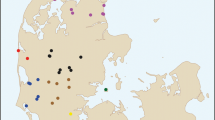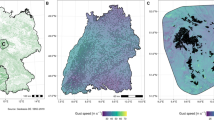Abstract
We examine the hypothesis of an increase of humus disintegration by analyzing chemical substances measured in the seepage water of a German forest. Problems arise because of a large percentage of missing observations. We use a regression model with spatial and temporal effects constructed in an exploratory data analysis. Spatial dependencies are modeled by random effects and an autoregressive structure for observations in distinct soil depths resulting in a recursive linear mixed model structure. Temporal dependencies are included by an autoregressive structure of the random effects. For parameter estimation an EM algorithm is deduced assuming the errors to be Gaussian. As a result of the data analysis we specify chemical substances which possibly affect the process of humus disintegration. In particular, we find evidence that the presence of aluminum ions is important, but because of the high correlations among the regressors this might be due to confounding with iron.
Similar content being viewed by others
References
Buonaccorsi, J. P., and Elkinton, J. S. (2002), “Regression Analysis in a Spatial-Temporal Context: Least Squares, Generalized Least Squares, and the Use of the Bootstrap,” Journal of Agricultural, Biological, and Environmental Statistics, 7, 4–20.
Cressie, N. A. C. (1993), Statistics for Spatial Data, New York: Wiley.
Dempster, A. P., Laird, N. M., and Rubin, D. B. (1977), “Maximum Likelihood from Incomplete Data via the EM Algorithm” (with discussion), Journal of the Royal Statistical Society, Series B, 39, 1–38.
Eichhorn, J. (1995), “Stickstoffsättigung und ihre Auswirkungen auf das Buchenwaldökosystem der Fallstudie Zierenberg,” Berichte des Forschungszentrums Waldökosysteme, Reihe A, 124, Göttingen, Germany.
Eichhorn, J., and Hüttermann, A. (1999), “Mechanisms of Humus Dynamics and Nitrogen Mineralisation,” in Going Underground—Ecological Studies in Forest Soils, eds. N. Rastin and J. Bauhus, Trivandrum (India): Research Signpost, pp. 239–277.
Fried, R. (1999), “Räumlich-zeitliche Modellierung der Kohlenstoffkonzentration im Waldbodensickerwasser zur Untersuchung der Hypothese der Humusdisintegration,” PhD thesis, Department of Mathematics, Darmstadt University of Technology, D-64289 Darmstadt, Germany.
— (2001), “Autoregressive Linear Mixed Models for Investigating Humus Disintegration,” Biometrical Journal, 43, 757–766.
Fried, R., Eichhorn, J., and Paar, U. (2001), “Exploratory Analysis and a Stochastic Model for Humus Disintegration,” Environmental Monitoring and Assessment, 68, 273–295.
Harrison, P. J., and Stevens, C. F. (1976), “Bayesian Forecasting,” (with discussion), Journal of the Royal Statistical Society, Series B, 38, 205–246.
Heinz, J., and Spellucci, P. (1994), “A Successful Implementation of the Pantoja-Mayne SQP Method,” Optimization Methods and Software, 4, 1–28.
Hodges, J. L., and Lehmann, E. L. (1954), “Testing the Approximate Validity of Statistical Hypotheses,” Journal of the Royal Statistical Society, Series B, 16, 259–268.
Jones, R.H. (1980), “Maximum Likelihood Fitting of ARMA Models to Time Series With Missing Observations,” Technometrics, 22, 389–395.
Kalman, R. E. (1960), “A New Approach to Linear Filtering and Prediction Problems,” Journal of Basic Engineering, 82, 34–45.
Longford, N. T. (1993), Random Coefficient Models, Oxford: Clarendon Press.
Schwarz, G. (1978), “Estimating the Dimension of a Model,” The Annals of Statistics, 6, 461–464.
Shumway, R. H., and Stoffer, D. S. (1982), “An Approach to Time Series Smoothing and Forecasting Using the EM Algorithm,” Journal of Time Series Analysis, 3, 253–264.
Ulrich, B. (1981), “Theoretische Betrachtung des Ionenkreislaufs in Waldökosystemen,” Zeitschrift für Pflanzenern ährung und Bodenkunde, 144, 647–659.
Wermuth, N. (1980), “Linear Recursive Equations, Covariance Selection, and Path Analysis,” Journal of the American Statistical Association, 75, 963–972.
West, M., and Harrison, J. (1989), Bayesian Forecasting and Dynamic Models, New York: Springer.
Wu, C. F. J. (1983), “On the Convergence Properties of the EM Algorithm,” The Annals of Statistics, 11, 95–103.
Author information
Authors and Affiliations
Corresponding author
Rights and permissions
About this article
Cite this article
Fried, R. An investigation of humus disintegration by spatial-temporal regression analysis. JABES 9, 138–157 (2004). https://doi.org/10.1198/1085711043127_a
Received:
Revised:
Issue Date:
DOI: https://doi.org/10.1198/1085711043127_a




